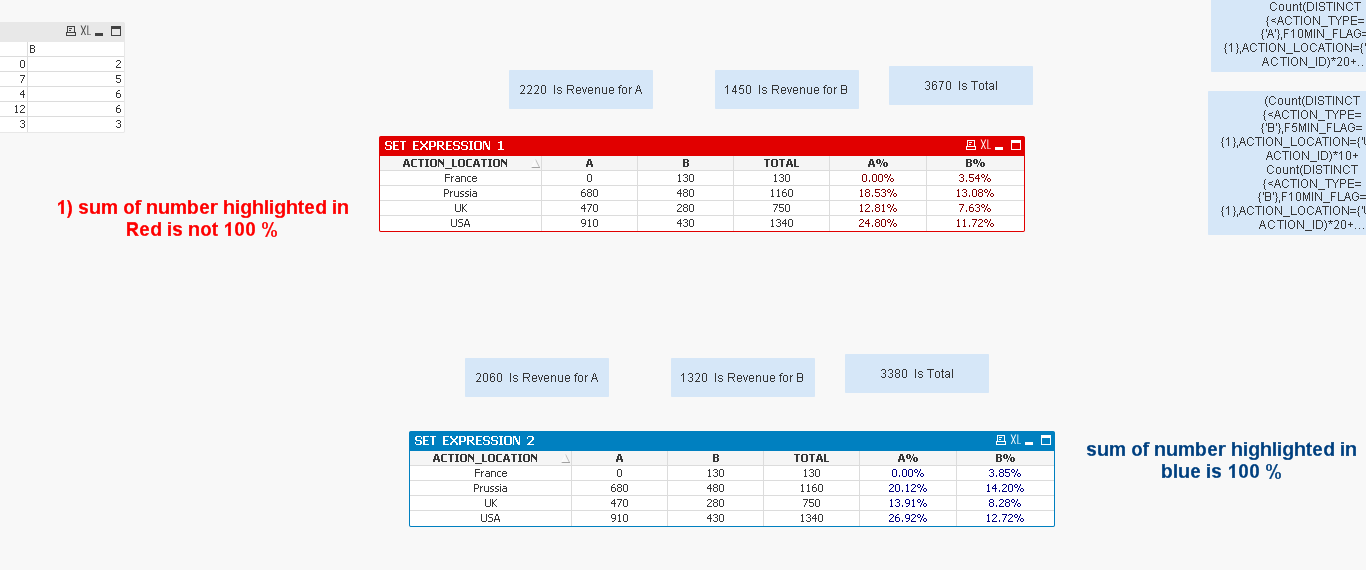Unlock a world of possibilities! Login now and discover the exclusive benefits awaiting you.
- Qlik Community
- :
- All Forums
- :
- QlikView App Dev
- :
- How to fix problem with of a set expression 1 , so...
- Subscribe to RSS Feed
- Mark Topic as New
- Mark Topic as Read
- Float this Topic for Current User
- Bookmark
- Subscribe
- Mute
- Printer Friendly Page
- Mark as New
- Bookmark
- Subscribe
- Mute
- Subscribe to RSS Feed
- Permalink
- Report Inappropriate Content
How to fix problem with of a set expression 1 , so that i get desired result similar to set expression 2 with least hard coding of values ?
Hi All ,
How to fix problem with of a set expression 1 , so that i get desired result similar to set expression 2 with least hard coding of values ?

THOUGH DATA IN FIRST THREE COLUMNS OF BOTH TABLE ARE COMING SAME WITH DIFFERENT SET EXPRESSION ,
WHAT SHOULD BE DONE , TO MAKE THE LAST TWO COLUMN OF 1ST TABLE SHOW SAME DATA LIKE LAST TWO COLUMN OF TABLE 2 .
Thanks & Regards
Shekar
Accepted Solutions
- Mark as New
- Bookmark
- Subscribe
- Mute
- Subscribe to RSS Feed
- Permalink
- Report Inappropriate Content
Try this as your variable's expression for vTotal
=Sum({<ACTION_LOCATION = {"*"}>}Aggr((Count(DISTINCT {<ACTION_TYPE={'A'},F5MIN_FLAG={1}>}ACTION_ID)*10+
Count(DISTINCT {<ACTION_TYPE={'A'},F10MIN_FLAG={1}>}ACTION_ID)*20+
Count(DISTINCT {<ACTION_TYPE={'A'},F15MIN_FLAG={1}>}ACTION_ID)*50+
Count(DISTINCT {<ACTION_TYPE={'A'},F20MIN_FLAG={1}>}ACTION_ID)*120+
Count(DISTINCT {<ACTION_TYPE={'A'},F30MIN_FLAG={1}>}ACTION_ID)*150)
+
(Count(DISTINCT {<ACTION_TYPE={'B'},F5MIN_FLAG={1}>}ACTION_ID)*10+
Count(DISTINCT {<ACTION_TYPE={'B'},F10MIN_FLAG={1}>}ACTION_ID)*20+
Count(DISTINCT {<ACTION_TYPE={'B'},F15MIN_FLAG={1}>}ACTION_ID)*50+
Count(DISTINCT {<ACTION_TYPE={'B'},F20MIN_FLAG={1}>}ACTION_ID)*120+
Count(DISTINCT {<ACTION_TYPE={'B'},F30MIN_FLAG={1}>}ACTION_ID)*150), ACTION_LOCATION))
- Mark as New
- Bookmark
- Subscribe
- Mute
- Subscribe to RSS Feed
- Permalink
- Report Inappropriate Content
stalwar1
Hi Sunny Bhai .. Please Help !!
- Mark as New
- Bookmark
- Subscribe
- Mute
- Subscribe to RSS Feed
- Permalink
- Report Inappropriate Content
Try this as your variable's expression for vTotal
=Sum({<ACTION_LOCATION = {"*"}>}Aggr((Count(DISTINCT {<ACTION_TYPE={'A'},F5MIN_FLAG={1}>}ACTION_ID)*10+
Count(DISTINCT {<ACTION_TYPE={'A'},F10MIN_FLAG={1}>}ACTION_ID)*20+
Count(DISTINCT {<ACTION_TYPE={'A'},F15MIN_FLAG={1}>}ACTION_ID)*50+
Count(DISTINCT {<ACTION_TYPE={'A'},F20MIN_FLAG={1}>}ACTION_ID)*120+
Count(DISTINCT {<ACTION_TYPE={'A'},F30MIN_FLAG={1}>}ACTION_ID)*150)
+
(Count(DISTINCT {<ACTION_TYPE={'B'},F5MIN_FLAG={1}>}ACTION_ID)*10+
Count(DISTINCT {<ACTION_TYPE={'B'},F10MIN_FLAG={1}>}ACTION_ID)*20+
Count(DISTINCT {<ACTION_TYPE={'B'},F15MIN_FLAG={1}>}ACTION_ID)*50+
Count(DISTINCT {<ACTION_TYPE={'B'},F20MIN_FLAG={1}>}ACTION_ID)*120+
Count(DISTINCT {<ACTION_TYPE={'B'},F30MIN_FLAG={1}>}ACTION_ID)*150), ACTION_LOCATION))
- Mark as New
- Bookmark
- Subscribe
- Mute
- Subscribe to RSS Feed
- Permalink
- Report Inappropriate Content
Thank You Sunny Bhai ...
Just wanted to check , how about applying above logic to data of 7000000 .
Which will be better the expression you gave or literally hard coding all possible Location like i did earlier .
Thanks & Regards
Shekar
- Mark as New
- Bookmark
- Subscribe
- Mute
- Subscribe to RSS Feed
- Permalink
- Report Inappropriate Content
**update : data of 7000000 and increasing daily
- Mark as New
- Bookmark
- Subscribe
- Mute
- Subscribe to RSS Feed
- Permalink
- Report Inappropriate Content
Where are you hard coding the locations?
- Mark as New
- Bookmark
- Subscribe
- Mute
- Subscribe to RSS Feed
- Permalink
- Report Inappropriate Content
(Count(DISTINCT {<ACTION_TYPE={'A'},F5MIN_FLAG={1},ACTION_LOCATION={'USA'}>}ACTION_ID)*10+
Count(DISTINCT {<ACTION_TYPE={'A'},F10MIN_FLAG={1},ACTION_LOCATION={'USA'}>}ACTION_ID)*20+
Count(DISTINCT {<ACTION_TYPE={'A'},F15MIN_FLAG={1},ACTION_LOCATION={'USA'}>}ACTION_ID)*50+
Count(DISTINCT {<ACTION_TYPE={'A'},F20MIN_FLAG={1},ACTION_LOCATION={'USA'}>}ACTION_ID)*120+
Count(DISTINCT {<ACTION_TYPE={'A'},F30MIN_FLAG={1},ACTION_LOCATION={'USA'}>}ACTION_ID)*150)
+
(Count(DISTINCT {<ACTION_TYPE={'A'},F5MIN_FLAG={1},ACTION_LOCATION={'Prussia'}>}ACTION_ID)*10+
Count(DISTINCT {<ACTION_TYPE={'A'},F10MIN_FLAG={1},ACTION_LOCATION={'Prussia'}>}ACTION_ID)*20+
Count(DISTINCT {<ACTION_TYPE={'A'},F15MIN_FLAG={1},ACTION_LOCATION={'Prussia'}>}ACTION_ID)*50+
Count(DISTINCT {<ACTION_TYPE={'A'},F20MIN_FLAG={1},ACTION_LOCATION={'Prussia'}>}ACTION_ID)*120+
Count(DISTINCT {<ACTION_TYPE={'A'},F30MIN_FLAG={1},ACTION_LOCATION={'Prussia'}>}ACTION_ID)*150)
+
(Count(DISTINCT {<ACTION_TYPE={'A'},F5MIN_FLAG={1},ACTION_LOCATION={'France'}>}ACTION_ID)*10+
Count(DISTINCT {<ACTION_TYPE={'A'},F10MIN_FLAG={1},ACTION_LOCATION={'France'}>}ACTION_ID)*20+
Count(DISTINCT {<ACTION_TYPE={'A'},F15MIN_FLAG={1},ACTION_LOCATION={'France'}>}ACTION_ID)*50+
Count(DISTINCT {<ACTION_TYPE={'A'},F20MIN_FLAG={1},ACTION_LOCATION={'France'}>}ACTION_ID)*120+
Count(DISTINCT {<ACTION_TYPE={'A'},F30MIN_FLAG={1},ACTION_LOCATION={'France'}>}ACTION_ID)*150)
+
(Count(DISTINCT {<ACTION_TYPE={'A'},F5MIN_FLAG={1},ACTION_LOCATION={'UK'}>}ACTION_ID)*10+
Count(DISTINCT {<ACTION_TYPE={'A'},F10MIN_FLAG={1},ACTION_LOCATION={'UK'}>}ACTION_ID)*20+
Count(DISTINCT {<ACTION_TYPE={'A'},F15MIN_FLAG={1},ACTION_LOCATION={'UK'}>}ACTION_ID)*50+
Count(DISTINCT {<ACTION_TYPE={'A'},F20MIN_FLAG={1},ACTION_LOCATION={'UK'}>}ACTION_ID)*120+
Count(DISTINCT {<ACTION_TYPE={'A'},F30MIN_FLAG={1},ACTION_LOCATION={'UK'}>}ACTION_ID)*150)
vs
Sum({<ACTION_LOCATION = {"*"}>}Aggr((Count(DISTINCT {<ACTION_TYPE={'A'},F5MIN_FLAG={1}>}ACTION_ID)*10+
Count(DISTINCT {<ACTION_TYPE={'A'},F10MIN_FLAG={1}>}ACTION_ID)*20+
Count(DISTINCT {<ACTION_TYPE={'A'},F15MIN_FLAG={1}>}ACTION_ID)*50+
Count(DISTINCT {<ACTION_TYPE={'A'},F20MIN_FLAG={1}>}ACTION_ID)*120+
Count(DISTINCT {<ACTION_TYPE={'A'},F30MIN_FLAG={1}>}ACTION_ID)*150)
+
(Count(DISTINCT {<ACTION_TYPE={'B'},F5MIN_FLAG={1}>}ACTION_ID)*10+
Count(DISTINCT {<ACTION_TYPE={'B'},F10MIN_FLAG={1}>}ACTION_ID)*20+
Count(DISTINCT {<ACTION_TYPE={'B'},F15MIN_FLAG={1}>}ACTION_ID)*50+
Count(DISTINCT {<ACTION_TYPE={'B'},F20MIN_FLAG={1}>}ACTION_ID)*120+
Count(DISTINCT {<ACTION_TYPE={'B'},F30MIN_FLAG={1}>}ACTION_ID)*150), ACTION_LOCATION))
- Mark as New
- Bookmark
- Subscribe
- Mute
- Subscribe to RSS Feed
- Permalink
- Report Inappropriate Content
Oh, are you asking which one is better between the two expressions for 7000000 + growing row of data?
I think set analysis is usually better, but if there are only 4 ACTION_LOCATION, it might not be too difficult to maintain the expression, but as it gets to grow, the maintenance will be an issue.
With regards to the Aggr() function, I don't think it should be too bad because we are only Aggregating for one dimension. but this should be something you will have to test and verify.
- Mark as New
- Bookmark
- Subscribe
- Mute
- Subscribe to RSS Feed
- Permalink
- Report Inappropriate Content
Actually I will have max of 5 locations of which 4 i have already shown .
" I think set analysis is usually better " .. If that is your point then i will go ahead with it . Yhank you ![]()